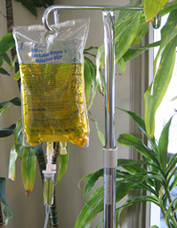 I have already written extensively about the potential of vitamin C as one of the most promising natural anti-cancer therapies. A new study published in may 2013 has found that anti-cancer concentrations of vitamin C can be achieved using large Intravenous (IV) doses.1 " Stephenson CM, Levin RD, Spector T, Lis CG. Phase I clinical trial to evaluate the safety, tolerability, and pharmacokinetics of high-dose intravenous ascorbic acid in patients with advanced cancer. Cancer Chemother Pharmacol. 2013 May 14." While it is still just a phase 1 clinical trial, it is another piece of information that can be added to the growing body of research supporting the safety and potential effectiveness of vitamin C. As a naturopathic doctor with a clinical interest in integrative cancer care, IV vitamin C is one of my most commonly used therapies. I find it improves quality of life, speeds recovery after chemo or radiation, prevents side effects if used before or duration radiation and can even prevent re-occurance of cancer. Despite common use and positive clinical effects, there still is need for more large-scale research in humans. This study further adds to the human evidence using vitamin C in cancer patients. With this recent study as a backdrop I am going to highlight the basic points of vitamin C use in oncology. Here are the facts we do know so far: 1) Vitamin C does possess direct anti-cancer effects in test-tube and mice models at serum concentrations above 1–5 mM2 2) Oral doses raise plasma (blood) levels to a maximum of 0.22 mM, well short of a direct anti-cancer effect.1 3) Doses of greater than 60g of IV vitamin C are required to make plasma levels cytotoxic to cancer cells.3 4) There have been 3 phase 1 clinical trials to date (now 4 with the most recent study published this month). These trials found IV vitamin C very safe and well tolerated but an anti-cancer effect was noted in only a few subjects. 1 5) IV vitamin C is safe with the majority of chemotherapeutic agents. There is even some evidence suggesting that it improves effectiveness and reduces side effects.1,4 There are still a number of key questions that remain unanswered in vitamin C research. What is the optimal dosage of IV vitamin C? How often should infusions be done? Is there a consistent anti-cancer effect achievable with high doses? Each clinician may have a different protocol depending on their interpretation of the evidence or clinical experience. Based on my clinical experience, I have found that there is no doubt that IV vitamin C, multi-mineral and multi-vitamin infusions improve the patient’s quality of life and prevent/resolve side effects associated with chemo or radiation. It is more difficult to discern the effect of high dose vitamin C since there are a number of other natural therapies often being used at the same time. This recent study attempts to shed more light on the effect of high dose vitamin C therapy in cancer patients. What Does It Tell Us? This new study pulled on all the experience and expertise of researchers and clinicians that have been working with high dose vitamin C for the last decade. 17 patients with various cancers were enrolled in the 4 week study and a number of different dosage groups were determined. Doses from 30-130g were administered. A specific IV protocol was used (vitamin C, calcium, magnesium and potassium) in order to maintain electrolyte balance during the infusions. The study determined that the optimal dose to maximize vitamin C concentration was 70g. Serum concentrations of 10-20nM were maintained for at least 5 hours at this dose. Higher doses did not have greater concentrations and did not last longer. The most common side effect was nausea and headaches but no serious side effects were noted at any dose. After 4 weeks, none of the patients have a measurable reduction is tumor size. The 4 week time frame is most likely not long enough to see a substantial tumor shrinking effect. Some patients did find an improvement in their quality of life. So what can conclude from this study? 1) The safety of high dose IV vitamin C therapy at dose greater than 100g. 2) Quality of life may improve after 4 weeks but the time frame may be to short to see a substantial tumor shrinking effect. 3) Doses of greater that 70g are needed to achieve a consistent maximal concentration greater than 30–40 mM in the plasma. We still are not certain what exact concentration has consistent anti-tumor effects in the mice. Based on this study and the other recent research the dose is most likely between 50 and 90g.1,5 4) A peak concentration of approximately 49 mM was achieved with a dose of 70g with a half life of 2 hours. Concentrations of 10-20nM were maintained for at least 5 hours at this dose. 5) Doses of greater that 80g don’t provide any additional benefit. It is nice to see another study using vitamin C in cancer care. I have to commend the authors on a good background of vitamin C evidence and solid study design. The clear short comings are that it did lack blinding and randomization. While definitive evidence is still lacking, we now have a greater understanding of dosage and frequency of treatment. Multiple treatments per week at doses of 70g would most likely yield positive effects according to this study. It is important to remember that vitamin C therapy is not all about a direct anti-cancer effect. Many clinicians report beneficial effects at much lower doses. We still don’t fully understand the many ways that vitamin C works in the human body. I do not doubt that when it comes to cancer, it most likely is impacting multiple pathways that promote the healthy function of our immune system which kills cancer cells and strengthens the supporting structure of healthy tissue around tumors thus impairing growth and spread. IV vitamin C remains one our best natural therapies against cancer and we eagerly await more research to shed more light on its effects. In Health Dr Paul References 1) Stephenson CM, Levin RD, Spector T, Lis CG. Phase I clinical trial to evaluate the safety, tolerability, and pharmacokinetics of high-dose intravenous ascorbic acid in patients with advanced cancer. Cancer Chemother Pharmacol. 2013 May 14. 2) Leung PY, Miyashita K, Young M, Tsao CS (1993) Cytotoxic effect of ascorbate and its derivatives on cultured malignant and nonmalignant cell lines. Anticancer Res 13:475–480 3) Riordan HD, Riordan NH, Jackson JA, Casciari JJ, Hunninghake R, Gonzalez MJ, Mora EM, Miranda-Massari JR, Rosario N, Rivera A (2004) Intravenous vitamin C as a chemotherapy agent: a report on clinical cases. P R Health Sci J 23:115–118 4) Verrax J, Calderon PB. The controversial place of vitamin C in cancer treatment. Biochem Pharmacol. 2008 Dec 15;76(12):1644-52. 5) Chen Q, Espey MG, Krishna MC, Mitchell JB, Corpe CP, Bu- ettner GR, Shacter E, Levine M (2005) Pharmacologic ascorbic acid concentrations selectively kill cancer cells: action as a pro- drug to deliver hydrogen peroxide to tissues. Proc Natl Acad Sci USA 102:13604–13609
2 Comments
Al Clouse
6/27/2013 04:02:10 am
Are you aware of a treatment using OZONE apparently developed in Germany. I would appreciate your thoughts Thanks
Reply
Dr Paul Hrkal
6/27/2013 12:40:42 pm
Hi Al,
Reply
Leave a Reply. |
Welcome To My Blog
My goal is to post thought-provoking and informative articles so you can learn and apply the latest news from the world of natural health. Feel free to post comments and start a conversation. Stay tuned to my twitter and facebook feeds for the latest posts.
Archives
December 2015
|

 RSS Feed
RSS Feed

